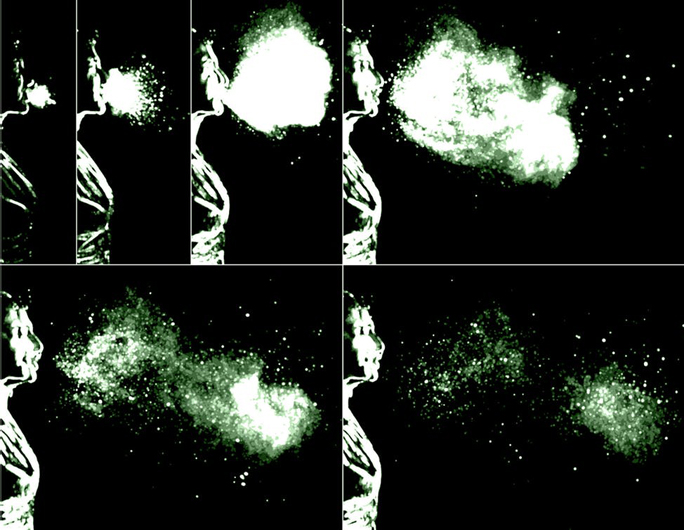How Far Does a Sneeze Travel?
Beware the sneeze! It bursts forth bearing droplets that can make us sick. So how far does a sneeze travel? Some studies suggest it could be farther than you think.
As long as we frequent public places—grocery stores, malls, plazas, restaurants, offices, schools, airports, train stations—it’s bound to happen. Someone walking toward us lets loose with a spontaneous sneeze. Can the germs suddenly floating in the air make us sick? To answer that question, let’s first address this one: How far does a sneeze travel?
Thanks to science, we have data that fills in the blanks. Well-publicized studies at Massachusetts Institute of Technology (MIT) in Cambridge, Mass., in 2014 and 2016 have given us clarity and real data on the physics of sneezing. The MIT researchers’ discoveries addressed not only a sneeze’s potential distance, but how fast a sneeze travels.
How Far Does a Sneeze Travel?
The MIT research team, led by Dr. Lydia Bourouiba, set out in its 2014 study to measure how far a sneeze can travel. Dr. Bourouiba is an MIT professor and head of a department called Fluid Dynamics of Disease Transmission Laboratory. She and her colleagues engaged 100 heathy volunteers and recorded them as they sneezed. When researchers required a sneeze, a simple nose tickle did the trick. High-tech cameras captured the action—the speed and force of the mucus, droplets, and snot expelled from the subjects—in minute detail.
The shocking answer uncovered by MIT: Sneezes can travel up to 200 feet. That’s about two-thirds the length of a football field. Imagine a quarterback in football airing out a bomb; strong-armed passers like Aaron Rodgers can heave a ball 67 yards in the air. That visual helps answer the question “How far does a sneeze travel?”
So how does it happen that a sneeze can travel so far?
Just like the data we’re typing into our computer can be “carried off” to that the great storage universe called “the Cloud,” we send our germs out in a cloud every time we sneeze. That’s right: When we sneeze (and also when we cough), we release gas clouds that preserve potentially infectious droplets and carry them far greater distances that previously thought.

These stop-action images from MIT’s sneeze study give you an idea of the force of a “multiphase turbulent buoyant cloud”—the droplet-carrying vehicle we expel during a sneeze.
John Bush, MIT professor of applied mathematics, co-authored the paper reporting on the study’s results. “When you cough or sneeze,” he wrote, “you see the droplets, or feel them if someone sneezes on you. But you don’t see the cloud—the invisible gas phase. The influence of this gas cloud is to extend the range of the individual droplets, particularly the small ones.”
Without the gas cloud, these smaller droplets would have a better chance of falling harmlessly on the ground within a few feet of the sneezer. Unfortunately, the gas cloud allows them to become airborne pathogens that travel anywhere from five to 200 times the distance. (We can’t help but think of them as hot air balloons carrying “travelers” that just happen to be germs.)
A Sneeze, Captured on Camera
In conjunction with sneezing volunteers, MIT researchers used technology to capture sneeze results. According to an MIT News report, “The researchers used high-speed imaging of coughs and sneezes, as well as laboratory simulations and mathematical modeling, to produce a new analysis of coughs and sneezes from a fluid-mechanics perspective. Their conclusions upend some prior thinking on the subject. For instance, researchers had previously assumed that larger mucus droplets fly farther than smaller ones, because they have more momentum, classically defined as mass times velocity.”
Instead, the small droplets, airlifted by our gas clouds, can be carried greater distances than even than the larger drops.
The researchers, in their paper, even have a name for those sneezed-out gas bubbles: “multiphase turbulent buoyant clouds.” So the next time someone sneezes without covering his nose, it’s okay to politely request that he keep his multiphase turbulent buoyant cloud to himself.
Upon publication of the first study’s results, newspaper and website headline writers glommed onto the “200-foot sneeze” angle. But keep in mind that not all sneeze debris travels that far. “The largest droplets rapidly settle within [about 3 to 6 feet] away from the person,” Dr. Bourouiba wrote.
Plus, there are “smaller and evaporating droplets that become trapped in a turbulent puff cloud,” Dr. Bourouiba added, and they remain suspended. Over the course of seconds to a few minutes, these smaller droplets “can travel the dimensions of a room and land up to [19 to 26 feet] away,” she noted.

When you feel a sneeze coming on, do a favor for those around you and let it escape into the crook of your arm.
Do Germs Travel by Sneeze?
Back to our original question: When we cross paths with a sneezing person, does it matter? Yes, and the sneezer doesn’t need to be a few feet away to spread his germs. The droplets can infect us even if the sneeze doesn’t land directly into our eyes or nose. MIT’s researchers point out that if the sneezer is all the way across a room, you’re still at risk.
Not to worry your inner germophobe, but… that “multiphase turbulent buoyant cloud” that’s carrying sneeze droplets can reach you from an entirely different room if common vents connect the rooms.
“The findings show that these clouds, particularly under usual conditions of temperature and buoyancy, have a tendency to go higher in the room and get sucked into the ventilation system,” according to co-author Bush. “I could be in this end of the building, and [yet] somebody could be in contact with my pathogens through from the ventilation system without me actually meeting that person.”
How Fast Does a Sneeze Travel?
Data collected by the Massachusetts Institute of Technology research team not only tells us how far a sneeze can travel, but it answers this question: “How fast does a sneeze travel?”
Amazingly, a sneeze can travel up to 100 m.p.h. As John Bush, MIT professor of applied mathematics, wrote, “Think of the cloud as being turbulent—that is to say, a very disordered, vigorous motion. If the characteristic speed in that cloud is larger than its settling speed, then it will be dominated more by that internal cloud motion than by its settling speed—meaning the smaller droplets go much further than the large drops.”
In the company of a sneezer, we instinctively turn away from the splatter—or we may slip outside to breathe in some fresh air. And, of course, we may be tempted to wash our hands—a good practice anyway to avoid the spread of germs. But because it’s difficult or near-impossible to see the droplet-bearing gas clouds produced by a sneeze, there may not be much you can do, other than to pray the droplets don’t get into your eyes, nose, or mouth—and, of course, to offer a quick “bless you” or “gesundheit.”
RECOMMENDED FOR YOU
- Cold vs. Allergies: What’s the Difference?
- Getting Sick After Flying? How to Prevent That Cold or Nasty Sinus Infection
- Antihistamines: Uses, Types, and Side Effects of a Popular Allergy Medication
- Where Germs Hide: Our “Filthy 5” Everyday Items May Shock You!
Originally published in 2018, this post is regularly updated.


 Hearing Aids Extend Longevity
Hearing Aids Extend Longevity  How to Fix a Droopy Eyelid
How to Fix a Droopy Eyelid  Droopy Eyelids Can Interfere with Vision
Droopy Eyelids Can Interfere with Vision 
How far does a sneeze travel? Farther than you think—and the droplets that fly from our nose and mouth don't necessarily stay in the same room....
Illustration 14392108 © Sebastian Kaulitzki - Dreamstime.com